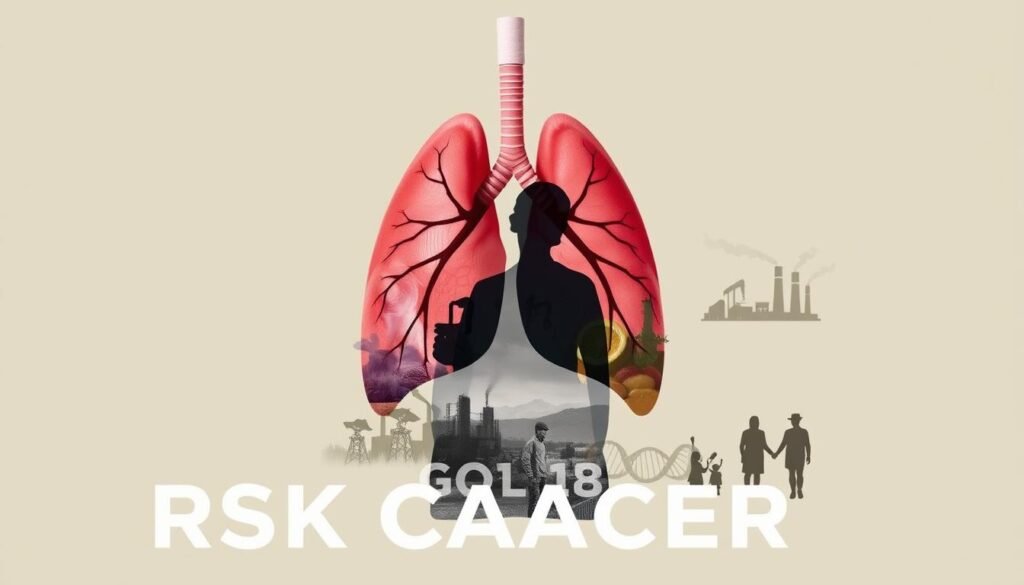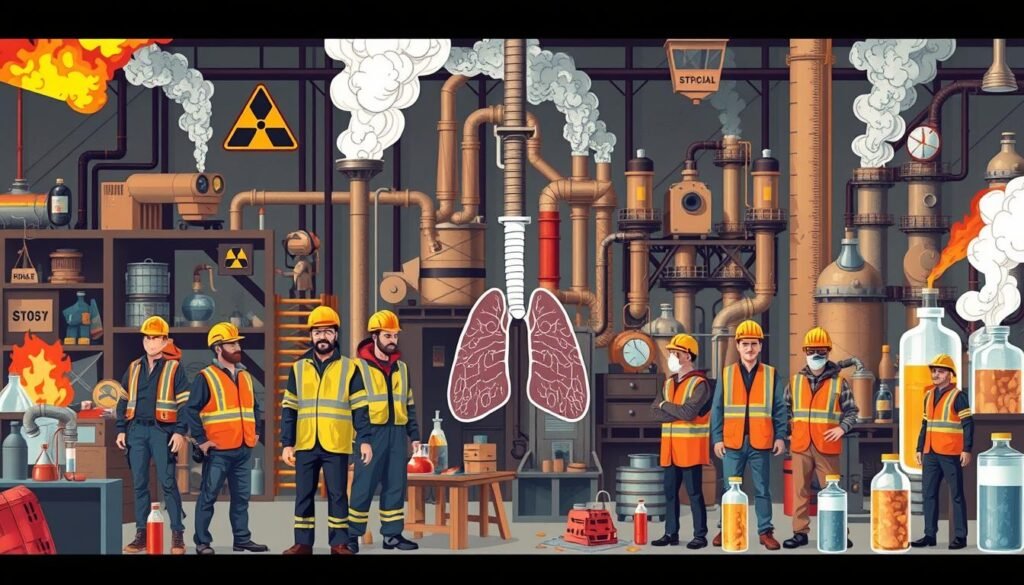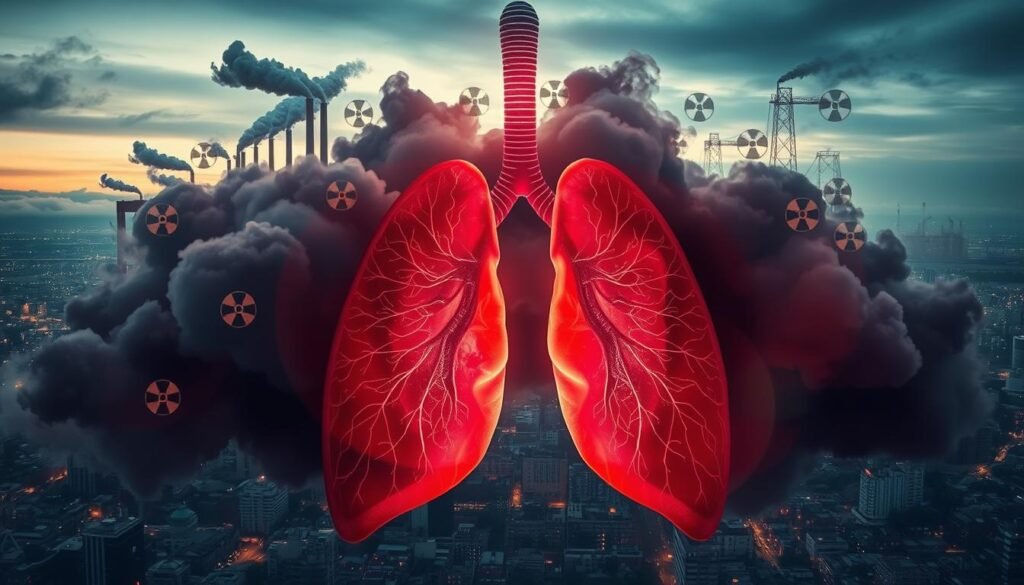About 80% of lung cancer deaths come from smoking. This fact is alarming, especially for small cell lung cancer (SCLC). SCLC mainly affects those who smoke a lot. Knowing the risks and early signs is key to better health.
Small cell lung cancer is both rare and aggressive. It’s mostly found in people who have smoked for years. This article shines a light on risk factors from smoking to bad environmental conditions. Understanding these can help prevent the cancer or catch it early, improving chances of beating it.
Key Takeaways
- Approximately 80% of lung cancer deaths are linked to smoking.
- Early detection is vital for effective treatment of small cell lung cancer.
- Secondhand smoke is a significant risk factor for lung cancer.
- Family history increases the likelihood of developing lung cancer.
- Poor air quality and occupational exposures contribute significantly to risk.
Understanding Small Cell Lung Cancer
Small cell lung cancer (SCLC) is a less known but very aggressive type of lung cancer. It makes up about 10-15% of all lung cancer cases. This cancer is different from the more common non-small cell lung cancer. SCLC grows quickly and often spreads early.
Smoking is the main cause of small cell lung cancer. Tobacco use greatly increases the risk of this serious cancer. Other risks include being around asbestos, secondhand smoke, and some chemicals. Older people, especially those over 65, are more at risk.
Small cell carcinoma, or oat cell cancer, is the most seen kind of SCLC. Combined small cell carcinoma is less common. To find this cancer, doctors use chest x-rays, CT scans, looking at spit under a microscope, and biopsies. Catching symptoms like constant coughing, feeling short of breath, and chest pain early helps with treatment. It can make the outcome better.
What are the main small cell lung cancer risk factors?
Knowing the risks linked to small cell lung cancer (SCLC) helps with prevention. Smoking is the top cause. It leads to about 90 percent of these cancer cases. The more and longer you smoke, the higher your SCLC risk grows.
Impact of Smoking History
Smoking has a big impact on SCLC risk. Both current and past smokers are at high risk. Men who start smoking before turning 15 are very much at risk. The term “pack-years” measures smoking quantity and its strong link to lung cancer. Quitting smoking lowers this risk, but former smokers are still more at risk than never-smokers. To understand more, check out the latest studies.
Secondhand Smoke Exposure
Being around smoke can also cause lung cancer in non-smokers. It can lead to heart and lung diseases too. Up to 30 percent of lung cancer in non-smokers comes from secondhand smoke and radon. This proves the clear connection between secondhand smoke and SCLC risk.
Family History of Lung Cancer
Having lung cancer in your family can double your own risk. If lung cancer affected close family members, your risk is even higher. This shows how both genes and environment affect SCLC risk. It’s vital to know your family’s health history.

Occupational Exposures and Their Impact on Lung Cancer Risk
Occupational hazards play a big part in raising lung cancer risk. Workers in certain fields are exposed to harmful substances. These include asbestos, diesel exhaust, and crystalline silica. People working in mining, construction, and manufacturing face greater dangers. This is because they come into constant contact with these toxic materials.

Getting lung cancer isn’t just about being exposed directly. Carcinogens mixed with tobacco smoke make things worse, increasing cancer risks greatly. Studies show that occupational hazards cause about 10% of lung cancer cases. This shows how crucial safety at work and proper rules are.
To lower these risks, taking steps to prevent exposure is important. Yet, harmful substances are still common at workplaces around the world. Teaching workers and bosses about safety and protective gear is essential. By keeping an eye on and bettering work environments, we can cut down on carcinogen contact.
| Carcinogen | Industry | Health Risks |
|---|---|---|
| Asbestos | Construction, shipbuilding | Increased lung cancer and mesothelioma risk |
| Diesel Exhaust | Transportation, construction | Heightened lung cancer risk, especially in smokers |
| Crystalline Silica | Mining, construction | Significantly increased lung cancer risk |
| Arsenic Compounds | Metal smelting | Association with lung and skin cancer |
| Nickel Compounds | Metal production | Increased risk of lung cancer |
In summary, work-related exposures have a big impact on lung cancer risks. Being aware and taking action is key to keeping workplaces safe. It’s vital to protect employees from dangerous substances.
Additional Environmental Risk Factors
Smoking is the top cause of lung cancer. But other environmental factors are also important. Radiation exposure and air pollution are major ones.
Radiation Exposure
Radiation from past cancer treatments can increase lung cancer risk. Radon gas from the earth is also dangerous. It causes about 21,000 lung cancer deaths yearly.
People living in homes with high radon levels are at greater risk. They breathe in this harmful gas over time.
Effects of Air Pollution
Air pollution is a big problem for lung health. Things like diesel exhaust and power plant smoke release dangerous particles. These particles can lead to lung cancer.
Over 108,000 lung cancer deaths a year are linked to outdoor air pollution. Indoor pollution from burning fuels is also a big risk, especially in poorer countries.

The Role of Chronic Lung Diseases
Chronic lung diseases greatly affect a person’s health. They are linked to a higher risk of lung cancer. COPD is a common chronic condition with serious effects on lung health. It is important to know how COPD and other chronic diseases affect lung health. This helps in recognizing the risks for lung cancer.
Understanding How Chronic Conditions Contribute to Risk
Chronic lung diseases hurt lung function and can damage the lungs over time. This damage can make the lungs prone to cancer. Studies show people with COPD are more likely to get lung cancer. Up to 50% of COPD patients might face this risk.
Smoking is the main cause of COPD and lung cancer. It’s a significant risk factor. Smokers have a much higher risk of lung cancer than non-smokers. Keeping an eye on lung health is crucial. Regular check-ups and early screenings can make a big difference in treatment success.
People with chronic lung problems should talk to their doctors about monitoring their health. Ongoing research is finding new ways to diagnose and treat these diseases. For more info, check out chronic lung diseases and lung cancer. You can also learn about lung cancer signs here.
Nutrition and Lung Cancer
Nutrition is key to staying healthy and can help prevent cancer. Eating right can boost lung health and lower lung cancer risks. It’s important to eat a variety of whole foods for better nutrition and cancer prevention.
The Importance of Diet in Cancer Prevention
Eating well can fight off oxidative stress and inflammation that lead to cancer. A diet rich in nutrients strengthens the body’s defenses. For lung cancer patients, avoiding nutritional deficiencies is crucial. Studies show that eating healthily can reduce the risk of getting cancer.
Foods to Include for Lung Health
Some foods are especially good for your lungs and might help prevent cancer. Here are a few:
- Fruits like oranges and strawberries are packed with vitamin C and can cut lung cancer risk.
- Leafy greens and cruciferous vegetables offer powerful antioxidants.
- Salmon and other fatty fish, loaded with omega-3 fatty acids, can reduce inflammation.
- Whole grains provide essential nutrients without unhealthy sugars.
- Legumes and nuts are great sources of fiber and vital nutrients.
Adding lung health foods to your diet supports your lungs and overall health. Eating whole foods and cutting out processed foods is best for cancer prevention.
| Food Type | Key Nutrients | Health Benefits |
|---|---|---|
| Fruits | Vitamin C, Antioxidants | May reduce cancer risk |
| Vegetables | Fiber, Vitamins A, C | Support lung health |
| Fatty Fish | Omega-3 Fatty Acids | Reduces inflammation |
| Whole Grains | Fiber, B Vitamins | Maintains healthy weight |
| Nuts and Legumes | Proteins, Healthy Fats | Improves immune function |
Preventive Measures for High-Risk Individuals
For people at high risk of small cell lung cancer, certain steps can greatly improve cancer prevention. It’s good to do regular screenings, like low-dose CT scans. These scans can find problems early. Stopping smoking is key since it’s linked to 87% of lung cancer deaths in the U.S.
Eating healthy and keeping a balanced weight are important for reducing risk. Including lots of fruits and vegetables in your diet helps. Even smokers can lower their lung cancer risk by eating more fruits and veggies. Also, it’s best to avoid beta-carotene supplements. They could raise smokers’ risk of getting lung cancer.
- Engaging in smoking cessation programs to eliminate tobacco use.
- Regular health check-ups to monitor lung health.
- Avoiding exposure to secondhand smoke and cancer-causing agents.
- Reducing radon levels in households, especially for smokers.
Healthcare professionals are crucial in making personalized plans for these individuals. By changing their lifestyle, people can not only cut their lung cancer risk but also boost their overall health. For detailed advice, check out cancer prevention strategies.
Signs and Symptoms of Small Cell Lung Cancer
Small cell lung cancer (SCLC) often goes unnoticed until it’s advanced. It’s because many lung cancer symptoms are easy to miss. The main symptoms include a bad cough that gets worse, chest pain, losing weight without trying, and feeling out of breath. If you’re coughing up blood or something that looks like rust, that’s serious. You should get help right away.
Noticing these signs early can really help catch the cancer sooner. That makes a big difference in treatment. But, it’s easy to think these symptoms are from something else that’s not cancer. That can delay getting the right diagnosis. Watch out for things like a cough that won’t go away, coughing up blood, pain in the chest that gets worse when you breathe deeply, a hoarse voice, not feeling hungry, losing weight without trying, feeling really tired, getting sick with bronchitis or pneumonia a lot, and starting to wheeze when you haven’t before.
- Persistent cough
- Coughing up blood
- Chest pain that worsens with deep breathing
- Hoarseness
- Loss of appetite
- Unexplained weight loss
- Shortness of breath
- Fatigue
- Recurring bronchitis or pneumonia
- Newly developed wheezing
As SCLC gets worse, you might feel more chest pain and other new problems. Cancer spreading can cause bone pain, changes in how your nervous system works, yellowing skin (jaundice), and swollen lymph nodes. Some kinds of tumors, like Pancoast tumors, might make one eyelid droop or one pupil get smaller. That’s called Horner syndrome. There’s also Superior vena cava syndrome, which causes swelling and breathing trouble. Both need quick medical care.
Knowing these signs helps you act fast to get checked out. If you’re seeing any of these lung cancer symptoms, especially if you smoke or cancer runs in your family, talk to a doctor. For more tips on spotting these symptoms, check out this guide.
Conclusion
Knowing the summary of risk factors for small cell lung cancer (SCLC) is key for prevention and early detection. This type of cancer makes up 15-20% of all lung cancers. It’s mainly found in people who smoke or used to smoke.
Workplaces with harmful substances like asbestos and indoor radon also raise the risk. These elements play a big role in developing SCLC.
SCLC’s outlook is worrisome, as 70% of patients find out they have it when it’s already advanced. This often means the cancer has spread far. It’s important to push for lung cancer awareness and the need for regular health checks.
By raising awareness, people can act early to lower their risks. This means not smoking and avoiding dangerous substances.
In short, focusing on prevention by knowing the risks is crucial. As science makes progress, staying informed and making smart health choices is essential. To learn more about SCLC risks, you can check out this study on lung cancer risk factors.